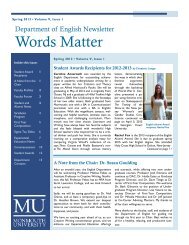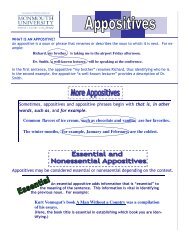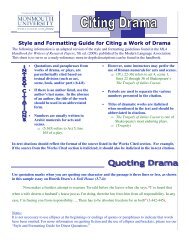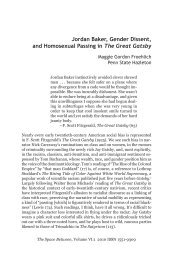WHAT IS A COMMA? • A comma is a punctuation mark that ...
WHAT IS A COMMA? • A comma is a punctuation mark that ...
WHAT IS A COMMA? • A comma is a punctuation mark that ...
You also want an ePaper? Increase the reach of your titles
YUMPU automatically turns print PDFs into web optimized ePapers that Google loves.
Verbal and Prepositional Phrases:<br />
⇒ Use a <strong>comma</strong> after a phrase <strong>that</strong> begins with a preposition, a participle, or an infinitive<br />
in a sentence.<br />
During the semester, I always have several papers to write.<br />
Knowing <strong>that</strong> she didn’t have time to go,<br />
To avoid pun<strong>is</strong>hment,<br />
<strong>•</strong> Note: Do not use a <strong>comma</strong> to set off a dependent clause at the end of a sentence.<br />
You can do the d<strong>is</strong>hes<br />
she kindly declined the invitation.<br />
the girl finally told the truth.<br />
after you have eaten.<br />
Mom always hangs her key by the door when she gets home.<br />
⇒ Use a <strong>comma</strong> to separate three or more words or phrases in a series.<br />
Mike’s favorite sports are football, soccer, and tenn<strong>is</strong>.<br />
She woke up early, ate breakfast, took a shower, and was on her way.<br />
⇒ A clause may be essential or nonessential depending upon its relationship to the<br />
meaning of the sentence. Nonessential clauses may be interesting to add, but the<br />
sentence would still be clear without it. Use <strong>comma</strong>s around nonessential clauses in a<br />
sentence. Note: If an essential or nonessential clause <strong>is</strong> describing a noun or pronoun<br />
in a sentence, it <strong>is</strong> called an appositive clause.<br />
Professor McEwan, the Director of the Writing Center, works Monday through Friday.<br />
Specifying <strong>that</strong> Professor McEwan <strong>is</strong> the Director of the Writing Center<br />
does not change the meaning of the sentence. Therefore, the Director of the<br />
Writing Center <strong>is</strong> a nonessential clause and <strong>is</strong> separated with <strong>comma</strong>s.<br />
The woman who <strong>is</strong> the Director of the Writing Center works Monday through Friday.<br />
However, in th<strong>is</strong> example, the clause “who <strong>is</strong> the Director of the Writing<br />
Center” <strong>is</strong> an essential clause because it identifies the woman being referred to in<br />
the sentence. Therefore, th<strong>is</strong> clause does not need <strong>comma</strong>s around it.














